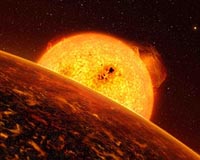 |
Bonn, Germany (SPX) Oct 13, 2009 Even in ancient times, people observed the planets that orbit our Sun. (See also the astronomy question from week 1: Why are there seven days in a week?) Nowadays we know that there are many trillions of other stars in the Universe, in addition to the Sun. It seems likely that planets orbit many of these stars too. The evidence that extrasolar planets (exoplanets for short) exist was obtained for the first time in the 1990s. However, exoplanets are small, non-luminous bodies that are light years away and as a rule indiscernible to us - how are we able to prove that they exist? Since 1995, over 370 exoplanets have been found - and there appears to be no end to the discoveries. Although astronomers have now succeeded in making a direct optical verification, two indirect astronomical measuring techniques have been shown to be particularly reliable in the search for exoplanets: the 'radial velocity' method and the 'transit' method.
Methods to verify the existence of extrasolar planets Due to the Doppler effect, in the electromagnetic spectrum of the star a radial movement such as this leads to a small periodic shift in the spectral lines - first towards the blue wavelength range, then back towards the red. If we analyse this movement of the spectral lines quantitatively, what is known as the radial-velocity curve can be derived from it. This yields parameters for the planetary orbit and the maximum mass of the planetary candidates. If the latter is less than the mass that a heavenly body requires to initiate thermonuclear fusion, the body is regarded as a planet. The transit method works if the orbit of the planet is such that, when viewed from the Earth, it passes in front of the star. During the planet's passage across the star disk, known as a transit, the planet's presence reduces the amount of radiation from the stellar disc that reaches the observer and a decrease in the apparent brightness of the star can be measured. The radius of the planet and its density can be calculated from these measurements together with other data (such as the distance of the star from Earth) - astronomers then know whether the planet in question is a rocky planet or a gas planet. Such findings are incorporated into models of how planets are formed and help us to better understand how planetary systems develop. Share This Article With Planet Earth
Related Links German Aerospace Center Lands Beyond Beyond - extra solar planets - news and science Life Beyond Earth
 Simulation Suggests Rocky Exoplanet Has Bizarre Atmosphere
Simulation Suggests Rocky Exoplanet Has Bizarre AtmosphereSt Louis MO (SPX) Oct 01, 2009 So accustomed are we to the sunshine, rain, fog and snow of our home planet that we find it next to impossible to imagine a different atmosphere and other forms of precipitation. To be sure, Dr. Seuss came up with a green gluey substance called oobleck that fell from the skies and gummed up the Kingdom of Didd, but it had to be conjured up by wizards and was clearly a thing of magic. ... read more |
|
| The content herein, unless otherwise known to be public domain, are Copyright 1995-2009 - SpaceDaily. AFP and UPI Wire Stories are copyright Agence France-Presse and United Press International. ESA Portal Reports are copyright European Space Agency. All NASA sourced material is public domain. Additional copyrights may apply in whole or part to other bona fide parties. Advertising does not imply endorsement,agreement or approval of any opinions, statements or information provided by SpaceDaily on any Web page published or hosted by SpaceDaily. Privacy Statement |